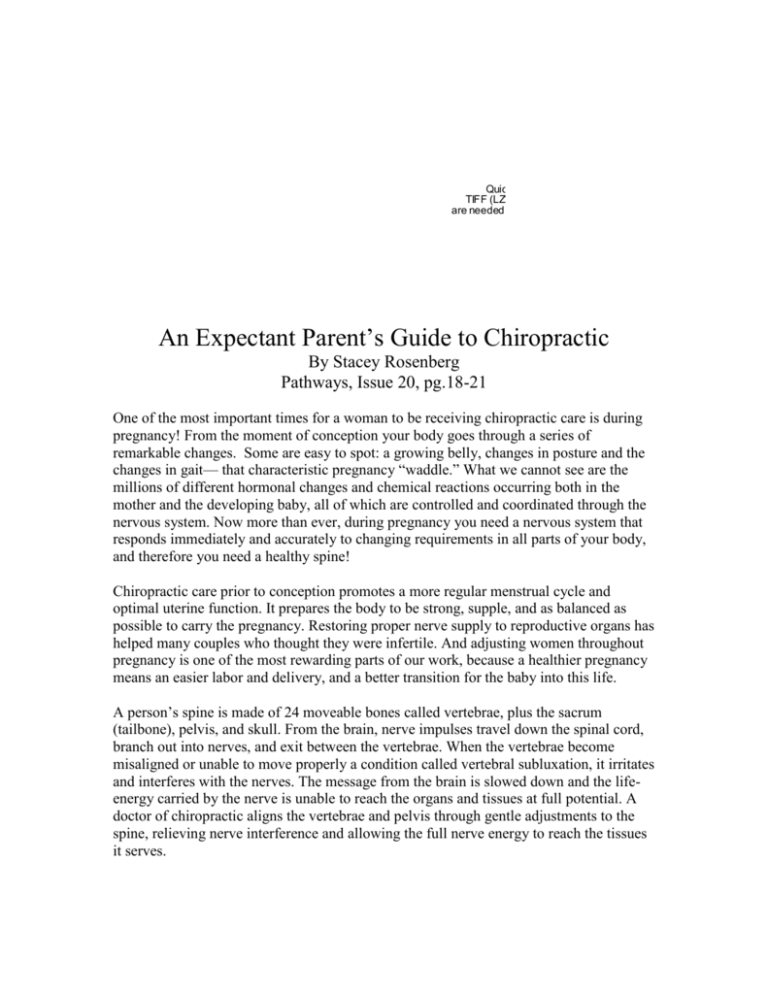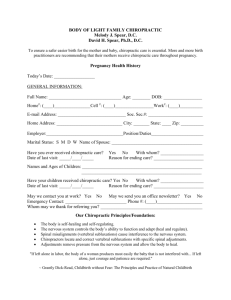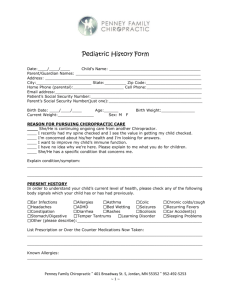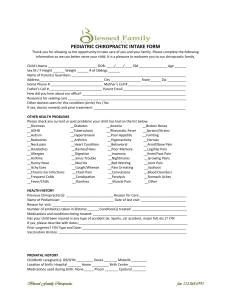read entire article... - Brent Family Chiropractic
advertisement

QuickTime™ and a TIFF (LZW) decompressor are needed to see this picture. An Expectant Parent’s Guide to Chiropractic By Stacey Rosenberg Pathways, Issue 20, pg.18-21 One of the most important times for a woman to be receiving chiropractic care is during pregnancy! From the moment of conception your body goes through a series of remarkable changes. Some are easy to spot: a growing belly, changes in posture and the changes in gait— that characteristic pregnancy “waddle.” What we cannot see are the millions of different hormonal changes and chemical reactions occurring both in the mother and the developing baby, all of which are controlled and coordinated through the nervous system. Now more than ever, during pregnancy you need a nervous system that responds immediately and accurately to changing requirements in all parts of your body, and therefore you need a healthy spine! Chiropractic care prior to conception promotes a more regular menstrual cycle and optimal uterine function. It prepares the body to be strong, supple, and as balanced as possible to carry the pregnancy. Restoring proper nerve supply to reproductive organs has helped many couples who thought they were infertile. And adjusting women throughout pregnancy is one of the most rewarding parts of our work, because a healthier pregnancy means an easier labor and delivery, and a better transition for the baby into this life. A person’s spine is made of 24 moveable bones called vertebrae, plus the sacrum (tailbone), pelvis, and skull. From the brain, nerve impulses travel down the spinal cord, branch out into nerves, and exit between the vertebrae. When the vertebrae become misaligned or unable to move properly a condition called vertebral subluxation, it irritates and interferes with the nerves. The message from the brain is slowed down and the lifeenergy carried by the nerve is unable to reach the organs and tissues at full potential. A doctor of chiropractic aligns the vertebrae and pelvis through gentle adjustments to the spine, relieving nerve interference and allowing the full nerve energy to reach the tissues it serves. As you gain weight, especially in the abdomen, this exerts a downward, forward pull on the lower spine. This extra weight combined with changes in your gait and centre of gravity can set the stage for backache and neck pain. Additionally, as labor approaches, your body secretes a hormone called relaxin, which loosens ligaments. This may exaggerate the effects of an existing spinal or pelvis problem. The positioning of the baby and its movement as well as expansion of the lower part of the ribcage to accommodate your growing baby can also cause discomfort in the ribs and upper portion of the lower back. Additionally, your increasing breast size in preparation for lactation can create upper back subluxations. According to recent studies, chiropractic care may result in easier pregnancy including increased comfort during the third trimester and delivery and reduced need for analgesics (pain medication). In one study, women receiving chiropractic care through their first pregnancy had 24% reduction in labor times and subjects giving birth for the second or third time reported 39% reduction in shorter labor times. In another study, the need for analgesics was reduced by 50% in the patients who received adjustments. In addition, 84% of women report relief of back pain during pregnancy with chiropractic care. When women receive chiropractic care throughout pregnancy, the sacroiliac joints of the pelvis function better. As a result, there is significantly less likelihood of back labor (contractions and sharp pain felt in the lower back during labor). Chiropractic care has helped new mothers become more comfortable breastfeeding (posture-wise) as well as to produce more milk. Chiropractic care has also been shown to reduce the likelihood of postpartum depression. As your pregnancy advances, some chiropractic techniques will need to be modified for your comfort. Your chiropractor is aware of this and will make the necessary changes. In particular, special pregnancy pillows and tables with drop- away pelvic pieces are used to accommodate your growing belly. Side-lying manual (diversified or Gonstead) lumbar or pelvic adjustments should be avoided in the second and third trimester due to patient discomfort and a small risk of disrupting the placental attachment from the uterine wall. A chiropractor trained in the techniques that address uterine constraint or malpresentations will check for misalignment of the pelvic bones, misalignment of the sacrum and vertebrae, and spasm of the ligaments that support the uterus and help hold the pelvis together. Body position during delivery is also critical. Any late second stage labor position that denies postural sacral rotation denies the mother and the baby critical pelvic outlet diameter and moves the tip of the sacrum up to four centimeters into the pelvic outlet. In other words, the popular semi-recumbent position that places the laboring woman on her back onto the apex of the sacrum closes off the vital space needed for the baby to get through the pelvic outlet. This delivery position is the main reason why so many births are traumatic, labor is stalled, the mom becomes fatigued and overwhelmed by pain, so the utilization of epidurals, forceps, episiotomies, vacuum extraction, and caesarean increases. This is why squatting is the preferred position—gravity works to help and the pelvic outlet can open to a greater degree. Squatting during delivery results in decreased use of forceps and a shorter second stage of labor than the semi-recumbent position! Moreover, research has shown that coached pushing in the second stage of labor does not improve the short-term outcome for mothers or babies, except when the baby needs to be born as quickly as possible. Coaching pushing has also been found to potentially increase the amount of pressure on the pelvic floor with subsequent negative consequences such as decreased bladder capacity, less urge to empty the bladder, an overactive bladder muscle, and stress incontinence (leakage of urine). Coaching pushing also involves “breath-holding” (so-called “purple pushing”) which can be very tiring, reduces oxygen levels in the mother and baby and increases the risk of tearing. An uncoached or a spontaneous second stage of labor allows you to work with the uterine contractions and the fetal expulsion reflex and allows the baby to descend without damage as you gently push/breath the baby out. We now know that ongoing, moderate, low-impact weight- bearing exercise during pregnancy can contribute to normal, on-time delivery and improve the likelihood of giving birth to a healthy, heavier baby. Unless there are medical reasons to avoid it, pregnant women can and should exercise moderately for at least 30 minutes on most, if not all, days. Exercise helps you feel better. The calories burned help prevent too much weight gain. Exercise can help pregnant women avoid gestational diabetes, a form of diabetes that sometimes develops during pregnancy. It can help build the stamina needed for labor and delivery. Exercise enhances well-being and promotes early recovery after labor and delivery. It’s also worth mentioning that exercise can be very helpful in coping with the postpartum period: exercise can help new mothers keep “baby blues” at bay, regain their energy and lose the weight they gained during pregnancy. Pregnancy Exercise Tips Don’t exercise for longer than 30 minutes at a time. Always include a 10-minute warm-up and a 10-minute cool-down period (in addition to the 30 minutes of exercise). Pregnant women should not exercise to exhaustion—but being fatigued is okay. Avoid forced, passive stretches, such as reaching for your toes. Pregnancy QuickTime™ and a hormones make your joints looser, so overstretching—which can cause a muscle TIFF (LZW) decompressor are needed to see this picture. injury—is a greater risk during pregnancy. Also, avoid sudden jerking or bouncing movements or quick changes in position. Limit aerobic activity to the low-impact variety, especially if you weren’t exercising regularly before getting pregnant. Brisk walking, swimming, and riding a stationary bicycle are good choices. Keep it moderate (30 minutes per day), particularly if you weren’t exercising before pregnancy. Ensure weight training is done under proper guidance. Measure your heart rate at peak activity to be sure you are not exceeding 140 beats per minute. Avoid overheating: drink plenty of water, and don’t exercise in hot, humid conditions. Avoid activities that put you at high risk for injury, such as horseback riding or downhill skiing. Avoid sports in which you could get hit in the abdomen (e.g. softball). Especially after the third month, avoid exercises that require you to lie flat on your back for an extended period of time since this can reduce your heart rate, lower your blood pressure, cause dizziness, and may reduce blood flow to baby. Never scuba dive because it can cause dangerous gas bubbles in the baby’s circulatory system. Before starting any new exercise routine, always check with your health care provider. Stop exercising immediately and consult your midwife or doctor if any of the following symptoms occur during or after exercise: bleeding, cramping, faintness and/or dizziness, elevated blood pressure, or severe joint pain. Here’s an easy pelvic tilt exercise to get you started. It will strengthen stomach and back muscles and reduce stress from the growth of your uterus. You may want to make sure you haven’t eaten for an hour or so before doing this exercise for comfort. 1. Lie flat on your back with your knees bent (this can also be done standing if you are uncomfortable on your back). 2. If needed, place a small pillow under your neck and/or lower back for support. Make sure you maintain a small curve in your neck to reduce the likelihood of strain. 3. Pull in abdominal and buttock muscles (this should flatten the lower back). Imagine you are peeling your buttocks and spine up off the floor. Slowly, vertebra-by-vertebra, rise to approximately bra-strap level (as long as there is no pain or tension felt in your neck). 4. Hold, breathe out, and count to five. 5. Relax. Inhale. Roll down slowly, and with control, vertebra- by-vertebra. 6. Repeat five times. Additional Hints to Help Prevent Pregnancy Backache Stand erect; do not allow your belly to sag. Change positions often to ease lower back strain. When lifting, bend your knees and keep your back straight. Consult your chiropractor for exercises to reduce lower back strain (an easy one to start with is the pelvic tilt shown above). Your mattress should be supportive and comfortable. Sleep on your side with a pillow between your knees. Adequate rest is essential. Keep daily chores manageable. Seek those who can most help you make this experience meaningful. Whether it’s a friend to walk with to the pool, a doula to help with your labor plan, or your mother offering to watch the kids or help clean the kitchen, take advantage of the help around you. Know your limits. If you are working throughout your pregnancy and/or have other children to care for, try not to overdo it. Practice good postural habits. Plan and do regular exercise. Kegel exercises are a great way to prepare and tone the pelvic floor muscles for delivery and can be done anytime. To do Kegels, contract the muscles around your urethra and vagina— imagine you are trying to prevent yourself from urinating. Hold for several seconds, then release. Repeat sets of ten, several times each day. Have regular spinal check-ups; they are an important part of preventative health care. Other Factors to Consider in Maintaining a Healthy Pregnancy Proper nutrition is essential to maintaining a healthy pregnancy. This includes adequate intake of folic acid, good sources of protein and iron, calcium-rich foods, and lots of fruits and vegetables. Drink plenty of pure water to keep well hydrated. Avoid eating too much sugar and sweets including fruit drinks as they can cause you (and the baby) to gain excessive weight. Research has found that a pregnant woman can help protect the health of her child by avoiding smoking and second-hand smoke alcohol, excessive caffeine (e.g. tea, coffee and cola), unnecessary exposure to x-rays (especially in the first trimester), unnecessary medication (including over-the-counter remedies), and foods with chemical additives, artificial sweeteners, and artificial ingredients. Regular exercise, good nutrition, and periodic spinal adjustments can make pregnancy the pleasant, exciting experience you want it to be! Pregnancy should be an opportunity to reflect on your family’s plans and dreams— not a time to struggle with pain. Preparing for a new baby is a daunting challenge for even the most organized mothers-to-be. So, during this meaningful time, be proactive: work to prevent backache before it affects your peace of mind or distracts you from focusing on your family’s well being. Chiropractic care is safe and natural, simply removing interference to your body’s own controlling and healing ability. View article references and author information here: www.pathwaystofamilywellness.org/references.html






